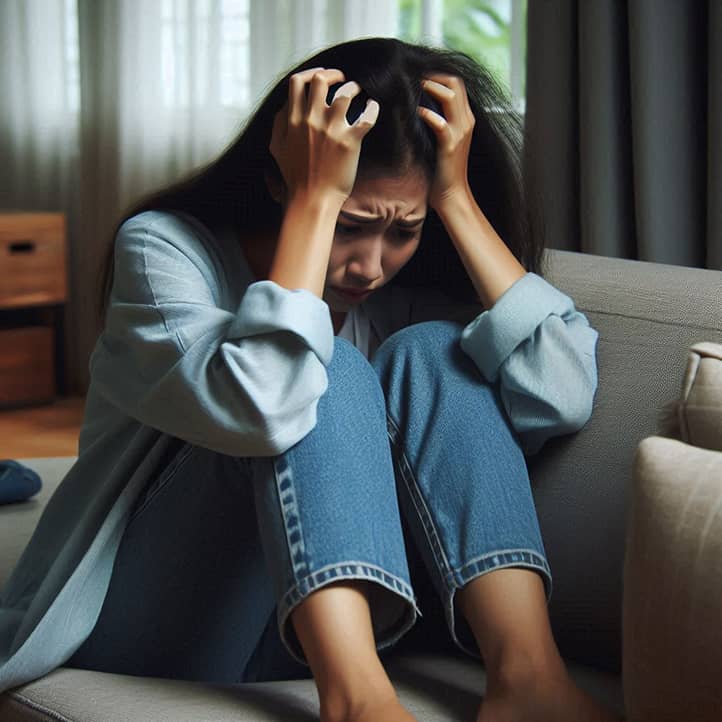Panic Disorder is a severe condition that can significantly disrupt a person’s quality of life. It is characterized by recurrent and unexpected episodes of intense fear, accompanied by physical symptoms. These episodes, known as panic attacks, can arise suddenly and without any clear cause, leaving the person feeling helpless and out of control.
Panic disorder is not merely a temporary state of anxiety. It is a clinical diagnosis requiring professional attention and treatment. People suffering from this disorder often experience intense fear of future attacks, which may lead to avoiding situations or places where they believe an episode might occur.
Panic disorder is not uncommon. According to various studies, 2% to 5% of the population encounters this condition at some point in their lives. Women are about twice as likely as men to suffer from panic disorder.
It is important to note that although panic disorder can occur at any age, it most often begins in late adolescence or early adulthood. This disorder can significantly impact a person’s daily life, work, and social relationships, especially if it remains undiagnosed and untreated.

Causes of Panic Disorder
The human brain is a complex system that responds to various internal and external factors. When this system becomes unbalanced, various mental disorders, including panic disorder, can arise. Understanding the causes of this condition not only aids in treatment but also provides hope for those suffering from it.
Research into the causes of panic disorder is a journey deep into human psychology and physiology. It not only allows for a better understanding of the mechanisms behind this condition but also facilitates the development of more effective methods of prevention and treatment.
Panic disorder rarely arises out of nowhere. It often results from a complex interaction of various factors that accumulate over time. Let’s examine the main ones.
Genetic Predisposition
Studies show that there is a genetic component in the development of panic disorder. People with close relatives who have this disorder are at increased risk. However, a genetic predisposition does not guarantee that a person will suffer from panic disorder; it merely increases the likelihood under certain conditions.
Neurobiological Factors
Research on the brains of people with panic disorder has revealed specific characteristics in the functioning of certain brain structures and neurotransmitter systems. In particular:
- Abnormalities in the amygdala, a brain region responsible for emotional reactions and fear.
- Imbalances in neurotransmitters, especially serotonin and norepinephrine, which play a significant role in regulating mood and anxiety.
- Increased sensitivity to carbon dioxide in the blood, which may cause shortness of breath and panic.
These neurobiological features may make a person more vulnerable to developing panic disorder.
Psychological Causes
Psychological factors play a significant role in the development and maintenance of panic disorder. These include:
- Increased anxiety and a tendency to worry.
- Negative beliefs and catastrophic thinking.
- Heightened attention to bodily sensations and misinterpretation of them.
- Low self-esteem and lack of confidence.
- Perfectionism and a desire for total control over situations.
These psychological traits may create a “favorable ground” for the development of panic disorder.
Stressful Events and Trauma
Panic disorder often develops after intense stress or traumatic experiences, such as:
- Loss of a loved one.
- Divorce or breakup of significant relationships.
- Financial problems or job loss.
- Serious illness or injury.
- Violence or life-threatening situations.
- Major life changes, even positive ones (e.g., moving, promotion).
Such events can exhaust the body’s adaptive resources and trigger the development of panic disorder in predisposed individuals.
Lifestyle and Environment
Certain aspects of lifestyle and environment can also contribute to the development of panic disorder:
- Chronic stress at work or in personal life.
- Lack of sleep or sleep disturbances.
- Unhealthy diet and lack of physical activity.
- Alcohol or substance abuse.
- Smoking and excessive caffeine intake.
- Living in a noisy, polluted, or unsafe environment.
These factors can increase overall stress and anxiety levels, making a person more vulnerable to panic attacks.
It is essential to understand that panic disorder usually arises from a complex interaction of several factors rather than a single specific cause. Recognizing these factors aids in preventing and treating the disorder.

Symptoms of Panic Disorder
A panic attack is not just intense fear. It is a complex bodily response affecting all systems, manifested through various symptoms. Each of these symptoms can be frightening on its own, and their combination is often perceived as a life-threatening situation.
Symptoms of panic disorder are not limited to the moment of the attack itself. They can appear as persistent anxiety, behavioral changes, and lifestyle alterations. These changes are often unnoticed by others but have a significant impact on a person’s quality of life.
Recognizing the symptoms of panic disorder is the first step in overcoming it. Understanding what happens to the body and mind during a panic attack helps reduce fear of this condition and start the recovery process.
Symptoms of panic disorder can be divided into three main categories: physical manifestations, emotional and cognitive symptoms, and behavioral changes. Let’s consider each category in more detail.
Physical Manifestations
Physical symptoms of a panic attack are often so intense that people may think they are having a heart attack or another life-threatening condition. Key physical symptoms include:
- Rapid heartbeat or feeling strong heartbeats.
- Excessive sweating.
- Shaking or trembling.
- Shortness of breath or feeling of suffocation.
- Chest pain or discomfort.
- Nausea or stomach discomfort.
- Dizziness, unsteadiness, or weakness.
- Numbness or tingling in the limbs.
- Hot flashes or chills.
- Dry mouth.
- Muscle tension.
These symptoms may vary in intensity and combination among different people and even in the same person during different attacks.
Emotional and Cognitive Symptoms
A panic attack is accompanied by intense emotional experiences and cognitive changes, including:
- Intense fear or terror.
- A sense of impending doom or disaster.
- Fear of losing control or going insane.
- Feeling of unreality (derealization).
- Feeling detached from oneself (depersonalization).
- Difficulty concentrating.
- Intrusive thoughts about potential negative consequences.
- A feeling of helplessness.
- Strong anxiety between attacks due to fear of another episode.
These symptoms can be just as frightening as physical manifestations and often amplify the overall sense of discomfort and fear.
Behavioral Changes
Panic disorder often leads to significant changes in a person’s behavior, which may include:
- Avoiding places or situations where panic attacks have occurred before.
- Limiting daily activities out of fear of new attacks.
- Dependence on others, unwillingness to be alone.
- Frequent visits to doctors with complaints about physical health.
- Alcohol or sedative use in an attempt to control symptoms.
- Difficulty fulfilling work or study obligations.
- Social isolation.
- Development of agoraphobia (fear of open spaces or places where help might be hard to reach).
It is important to note that panic disorder symptoms can vary in frequency and intensity. Some people have attacks several times a week, while others experience them only a few times a year. Some individuals may live in constant anticipation of the next attack, which itself becomes a major source of stress.

Diagnosis of Panic Disorder
The diagnostic process for panic disorder requires a comprehensive approach. It includes not only an assessment of the patient’s psychological state but also a thorough physical examination. This is necessary to rule out other medical conditions that may cause similar symptoms.
Modern diagnostic methods for panic disorder are constantly improving. They allow not only for an accurate diagnosis but also for the identification of individual features of the disorder in each patient, which is crucial for selecting effective treatment.
Diagnostic Criteria
According to the Diagnostic and Statistical Manual of Mental Disorders (DSM-5), the following criteria must be met for a diagnosis of “panic disorder”:
- Recurrent unexpected panic attacks.
- At least one attack has been followed by one month (or more) of one or both of the following:
- Persistent concern about having additional attacks.
- Worry about the implications of the attacks (e.g., losing control, having a heart attack).
- Significant behavior changes related to the attacks.
- The attacks are not due to the physiological effects of substances (e.g., drugs, medications) or other medical conditions.
- The attacks are not better explained by other mental disorders.
Examination Methods
The diagnosis of panic disorder typically includes the following methods:
- Clinical Interview. A psychiatrist or psychologist conducts a detailed conversation with the patient, asking about symptoms, their frequency, duration, and impact on daily life.
- Physical Examination. This is necessary to rule out other medical conditions that may cause similar symptoms (such as heart issues or thyroid problems).
- Laboratory Tests. These may include blood tests to check thyroid hormone levels, electrolytes, and other indicators.
- Psychological Testing. Specific questionnaires and scales are used to assess anxiety levels and other psychological symptoms.
- Cardiological Examination. This may include an ECG or other tests to rule out heart problems.
- Neurological Examination. This may be necessary to rule out neurological causes of the symptoms.
It is important to note that diagnosing panic disorder can be quite challenging because its symptoms often resemble those of other conditions. Therefore, a comprehensive approach and sometimes consultations with multiple specialists are needed.
Accurate diagnosis is critical for prescribing appropriate treatment. If you suspect you may have panic disorder, consult a qualified specialist—either a psychiatrist or a clinical psychologist specializing in anxiety disorders.

Treatment for Panic Disorder
Treating panic disorder goes beyond merely alleviating symptoms; it’s a comprehensive process aimed at restoring a person’s psychological well-being. Modern medicine offers a wide array of methods to effectively address this condition.
Choosing the right treatment approach is key to successfully overcoming panic disorder. Each case is unique, and what works for one person may not be effective for another, making an individualized approach essential.
Treating panic disorder requires not only the expertise of professionals but also the active involvement of the patient. A willingness to change, openness to new experiences, and persistence in following medical advice play a major role in the recovery process.
Treatment for panic disorder generally includes a combination of various approaches. The primary methods are psychotherapy and medication. Let’s look at each method in detail.
Psychotherapy
Psychotherapy is one of the most effective treatments for panic disorder. The main types of psychotherapy used are:
- Cognitive-Behavioral Therapy (CBT) is considered the “gold standard” in treating panic disorder. It helps patients to:
- Recognize and change negative thoughts and beliefs related to panic attacks;
- Learn relaxation and stress-management techniques;
- Develop skills for managing symptoms.
- Exposure Therapy is often used as part of CBT. This method involves gradually and safely confronting fear-inducing situations to help patients realize these situations are actually safe and that panic symptoms are manageable.
- Psychodynamic Therapy focuses on exploring unconscious conflicts and experiences that may underlie panic disorder.
- Group Therapy enables patients to participate in support or therapeutic groups, helping them feel less isolated and learn from others with similar issues.
Medication Treatment
Medication can be effective in reducing symptoms of panic disorder, especially when combined with psychotherapy. The main classes of medications used for treating panic disorder include:
- Selective Serotonin Reuptake Inhibitors (SSRIs):
- Medications: fluoxetine, paroxetine, sertraline, etc.
- Mechanism of Action: increase serotonin levels in the brain, which helps reduce anxiety and panic.
- Advantages: effective with relatively few side effects.
- Serotonin and Norepinephrine Reuptake Inhibitors (SNRIs):
- Medications: venlafaxine, duloxetine.
- Mechanism of Action: affect serotonin and norepinephrine levels in the brain.
- Useful when SSRIs do not yield desired results.
- Benzodiazepines:
- Medications: alprazolam, clonazepam, etc.
- Mechanism of Action: quickly reduce anxiety and panic.
- Typically used short-term due to risk of dependency.
- Beta-blockers:
- Medications: propranolol, atenolol.
- Mechanism of Action: reduce physical symptoms of anxiety, like rapid heartbeat.
- Useful for controlling specific panic symptoms.
It is important to note that medication treatment should only be conducted under the supervision of a qualified psychiatrist. Medications may have side effects and interact with other drugs.
Combined Approach
Research indicates that a combination of psychotherapy and medication often yields the best results for treating panic disorder. This approach allows for:
- Rapid relief of symptoms with medication;
- Teaching long-term symptom management strategies through psychotherapy;
- Reducing the risk of relapse after medication is discontinued.
The choice of a specific treatment method or combination depends on the individual patient’s characteristics, symptom severity, and the preferences of both the patient and the treating physician.

Self-Help for Panic Disorder
Self-help for panic disorder is not simply an addition to professional treatment but an essential component of recovery. Mastering self-help techniques gives individuals a sense of control over their condition, which is itself a powerful therapeutic factor.
Self-help methods for panic disorder vary and cover different aspects, from breathing techniques to lifestyle changes—each aspect contributing to the overall recovery process.
Self-help requires patience and persistence. Results may not be immediately noticeable, but over time, even small changes accumulate, leading to significant improvements.
Relaxation Techniques and Breathing Exercises
-
- Deep Breathing:
- Take a slow, deep breath in through your nose, counting to 4;
- Hold your breath for 2 seconds;
- Exhale slowly through your mouth, counting to 6;
- Repeat 5-10 times.
- Progressive Muscle Relaxation:
- Tense and then relax different muscle groups sequentially, starting from the feet and ending with the face.
- This helps reduce overall muscle tension and calm the nervous system.
- Mindfulness Meditation:
- Focus on the present moment, paying attention to your breathing or body sensations.
- Practice accepting your thoughts and feelings without judgment.
- Visualization:
- Imagine a calm, safe place;
- Describe this place in detail, using all of your senses.
- Deep Breathing:
Regular practice of these techniques helps reduce overall anxiety levels and improves symptom management.
Regular Physical Exercise
Physical activity plays a vital role in managing symptoms of panic disorder:
- Aerobic Exercise:
- Running, walking, swimming, cycling—30 minutes, 3-5 times a week.
- Helps reduce stress and improves mood.
- Yoga:
- Combines physical exercise with relaxation and meditation techniques;
- Can help reduce anxiety and improve well-being.
- Strength Training:
- Enhances both physical and mental health;
- Boosts self-esteem and confidence.
- Dance or Team Sports:
- Adds an element of social interaction;
- Provides distraction from anxious thoughts.
Choose a type of physical activity that brings enjoyment, and gradually increase the intensity.
Healthy Lifestyle
General lifestyle changes can greatly mitigate panic disorder symptoms:
- Sleep:
- Aim for 7-9 hours of sleep each night;
- Establish a regular sleep schedule;
- Create a comfortable sleep environment.
- Nutrition:
- Eat regularly without skipping meals;
- Include omega-3-rich foods in your diet (fish, nuts, seeds).
- Limiting Stimulants:
- Reduce caffeine intake;
- Avoid nicotine;
- Limit alcohol consumption.
- Social Support:
- Stay connected with friends and family;
- Share your feelings with loved ones;
- Consider joining a support group.
Stress Management Training
Developing stress-management skills helps prevent panic attacks and improves coping:
- Time Management:
- Make a to-do list and set priorities;
- Break down large tasks into smaller, manageable parts;
- Don’t hesitate to say “no” to additional obligations.
- Setting Realistic Goals:
- Set achievable goals;
- Celebrate even small successes.
- Positive Thinking:
- Practice positive affirmations;
- Try to replace negative thoughts with more realistic or positive ones.
- Hobbies and Recreation:
- Find an activity that brings joy and helps you relax;
- Set aside regular time for rest and leisure.
- Keeping a Journal:
- Write down your thoughts and feelings to identify panic attack triggers and track progress.
Remember that self-help does not replace professional treatment but can be an essential addition to it. If symptoms persist or worsen despite using self-help methods, consult a specialist.

Support from Loved Ones and Environment
Panic disorder affects not only the individual but also those around them. Loved ones often feel helpless, unsure how to respond to panic attacks and support their family member or friend. Recognizing the role of support from one’s environment is a key factor in the recovery process.
Support from loved ones creates a safe space where a person with panic disorder feels accepted and understood. This helps reduce the social isolation that often accompanies the condition and fosters a connection with the outside world.
Educating loved ones on how to respond effectively to panic attacks and better understand the nature of the disorder can significantly improve the quality of life for the entire family. This transforms the journey of managing panic disorder from an individual struggle to a collective process where each family member plays an important role.
How to Help Someone with Panic Disorder?
- Education:
- Learn about panic disorder.
- Understand what the person experiences during a panic attack.
- Realize that the symptoms are real and involuntary.
- Emotional Support:
- Listen without judgment.
- Show empathy and understanding.
- Assure the person that you are there and ready to help.
- Practical Help:
- Offer to accompany the person in anxiety-inducing situations.
- Assist in finding professional help.
- Support adherence to the treatment regimen.
- During a Panic Attack:
- Stay calm and confident.
- Remind the person it’s a panic attack and that it will pass.
- Offer help with breathing exercises.
- Encouraging Progress:
- Acknowledge even small successes.
- Support them in overcoming fears.
- Patience:
- Remember that recovery takes time.
- Avoid rushing the process or pressuring the person.
The Importance of Understanding and Empathy
Understanding and empathy from loved ones play a crucial role in overcoming panic disorder:
- Reducing Stigmatization:
- Open discussion helps diminish feelings of shame and isolation.
- Normalizing the experience of those with panic disorder.
- Creating a Safe Environment:
- The individual feels they can seek help without fear of judgment, leading to more open communication about symptoms and challenges.
- Improving Self-Esteem:
- Support from loved ones helps the person feel valued and loved, boosting self-confidence and motivation for recovery.
- Reducing Social Isolation:
- Understanding from others enables the individual to remain socially active, which prevents worsening symptoms due to isolation.
- Support in Treatment:
- Empathy from loved ones often motivates the person to continue treatment.
- Family members can help adhere to medical recommendations and therapy assignments.
- Lowering Overall Stress Levels:
- A supportive environment creates a calmer atmosphere, reducing the frequency and intensity of panic attacks.
It’s important to remember that support from loved ones doesn’t replace professional help but is an essential complement to it. If you are close to someone with a mental health disorder, take care of your emotional state as well. Supporting someone with a mental disorder can be emotionally exhausting, so finding a balance between helping and self-care is essential.

Preventing Panic Attacks
Effective prevention of panic attacks relies on a deep understanding of personal triggers and mechanisms that lead to episodes. This requires consistent self-monitoring and self-assessment, which are essential skills in emotional regulation.
Preventative measures often go beyond simply avoiding stressful situations. They include developing new stress management skills, strengthening self-confidence, and creating a supportive environment.
While it may not always be possible to entirely prevent panic disorder, there are steps to reduce the risk of developing this condition or lessen the frequency and severity of panic attacks.
Early detection of symptoms
- Recognizing the Early Signs:
- Be aware of heightened anxiety.
- Note any changes in stress reactions.
- Pay attention to physical symptoms like a rapid heartbeat or chest discomfort.
- Symptom Diary:
- Record when and where anxious thoughts or physical symptoms occur.
- Note what preceded these feelings to identify triggers and patterns.
- Regular Self-Assessment:
- Periodically “check in” on your emotional state.
- Use anxiety scales for an objective evaluation.
- Seeking Help Early:
- Don’t ignore persistent anxiety symptoms.
- Consult a psychiatrist or psychologist if you feel unable to manage alone.
Regular Monitoring by Specialists
- Preventive Visits:
- Regularly see a psychologist or psychiatrist, even if you feel well; this can help detect and address issues early.
- Monitoring Treatment Effectiveness:
- If you are undergoing treatment, discuss its effectiveness with your doctor;
- Be prepared to adjust your treatment plan if necessary.
- Physical Examinations:
- Attend routine medical check-ups;
- This helps rule out physical causes of symptoms and supports overall health.
- Education:
- Participate in educational programs on anxiety disorders;
- Stay informed about new treatment methods and self-help techniques.
- Maintaining a Healthy Lifestyle:
- Discuss strategies with your doctor for maintaining a healthy lifestyle;
- Follow recommendations on nutrition, physical activity, and sleep.
Remember, preventing panic attacks is not a one-time event but an ongoing process of caring for your mental health. Regularly applying self-help strategies, maintaining a healthy lifestyle, and timely consultation with specialists can significantly improve your quality of life and reduce the risk of recurrence.

Conclusion
Panic disorder is a serious condition that can greatly affect a person’s quality of life. However, it’s important to remember that it is not a life sentence but a manageable problem. With the right approach and support, most people achieve significant improvements in their condition and return to a fulfilling life.
The key to overcoming panic disorder lies in a comprehensive approach, which includes professional treatment, self-help, and support from those around you. Understanding the nature of the disorder, its symptoms, and treatment methods provides patients and their loved ones with tools for effectively managing this condition.
With proper treatment, the prognosis for panic disorder is favorable in most cases. Many people achieve full remission or significant symptom reduction. Remember, recovery is a process that requires time and effort, but the result is worth it.
Through treatment, patients not only alleviate symptoms but also gain valuable skills for managing stress and anxiety, which can be beneficial in various life situations. This makes overcoming panic disorder an important stage in personal growth and development.
If you are experiencing symptoms of panic disorder, don’t hesitate to reach out to a psychologist or psychiatrist. Remember, seeking help is a sign of strength, not weakness. With the right treatment and support, it is possible to learn to manage symptoms and return to a full, happy life.




